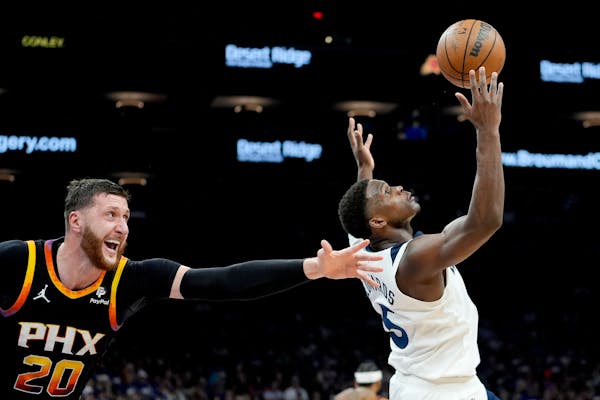Black History Month is over but exhibitions featuring Black art, history, culture and joy continue through the end of March and into spring. A re-creation of the first Black-owned gay bar in San Francisco, explorations into okra and the color indigo, and the possibility of a new month called Black Mystery Month offer perspectives from contemporary artists, and exhibitions at the Minnesota Historical Society and the Minneapolis Institute of Art delve into complex histories of racism.
'The New Eagle Creek Saloon'
Artist Sadie Barnette's re-creation of her father's Black-owned gay bar in San Francisco offers a different spin on the idea of living archive. Her dad, Rodney Barnette, ran Eagle Creek Saloon from 1990-1993, envisioning it as a safe haven for people experiencing racism and homophobia.
At the Walker, Barnette brings it back to life through neon pink signage, a sleek U-shaped bar, comfy square-shaped bar stools. Every Thursday while the show is open, visitors can join in on "Come Together," a series of parties hosted by and celebrating local Black queer artists. Queer/BIPOC Mama San Collective serves drinks (for a fee), and an array of DJs spin music. The exhibition includes archival imagery from the original bar and queer history that mentions familiar local joints such as the Saloon, the 19 Bar and the Gay 90s. Ends May 19. (Exhibition is free during happy hours on Thu., 6 p.m., 5-9 p.m. March 21-April 19. Regular Walker hours: 10 a.m.-5 p.m. Wed. & Fri.-Sun., 10 a.m.-9 p.m. Thu., Walker Art Center, 725 Vineland Place, Mpls., $2-$18, 612-375-7600 or walkerart.org)
Ta-Coumba T. Aiken
Dreamsong Gallery hosts "Can't Turn Around," the second solo exhibition of Guggenheim-winning artist, activist and educator Ta-Coumba T. Aiken. Working in painting, drawing and collage, Aiken's work is multilayered. His abstract, intuitive-oriented work comes from a process he calls "spirit writing," which brings in corporeal elements of the artist's ancestors and shared histories. The exhibition includes all new works, from colorful abstractions filled with tunnels of squiggly lines, webs and cosmic outlines to black-and-white paintings where faces loom large. Ends April 20. (12-5 p.m. Wed.-Sat., Dreamsong Gallery, 1237 NE. 4th St., Mpls., free, dreamsong.art or 646-703-4473 or 917-373-0216)
Azania Tripp
In Minnesota African American Heritage Museum and Gallery's artist-in-residence exhibition "Okra and Indigo," Azania Tripp uses collage to explore the stories of historical chefs within the Black/African American community, and Black Minnesotans' relationship to food. Tripp, who is Black and Singaporean, focuses on okra, a staple food across the African diaspora but one that she didn't learn about until adulthood. She also uses indigo throughout the exhibit because of its East Asian origin and how the indigo plant has been used as a cash crop in the United States. The St. Cloud-born artist — who also runs Obsidian Pause| Wearable Paper Art, creating lightweight multimedia collage earrings, apparel and accessories — is also the sister of comedian Comrade Tripp. Ends March 30. (1-5 p.m. Tue.-Fri., 10 a.m.-2 p.m. Sat., Minnesota African American Heritage Museum and Gallery, 1256 Penn Av. N., 4th floor, Mpls., free, maahmg.org)
Black life under Jim Crow
According to the U.S. Constitution, by 1868 all people born in America were equal, but the harsh "separate but equal" age known as Jim Crow showed otherwise. This exhibition at the Minnesota History Center, organized by the New-York Historical Society, looks at Black advancement from the end of the Civil War through World War I during a time of ongoing racism. Art, artifacts and photographs show Black resistance and resilience. Ends June 9. (10 a.m.-4 p.m. Wed., Fri.-Sun, 10 a.m.-8 p.m. Thu., 345 W. Kellogg Blvd., St. Paul, $8-$12, free for kids under 4, 651-259-3000 or mnhs.org)
'American Gothic: Gordon Parks & Ella Watson'
"American Gothic: Gordon Parks & Ella Watson," a collection of 60 black-and-white pictures that Parks shot in 1942, offers a snapshot of Washington, D.C., at the time, and the dynamic relationship between a young Parks and his muse-like friend, Watson. She is the centerpiece of his iconic "American Gothic" photograph, in which she holds a mop, unsmiling and stern, in front of a backdrop of an American flag. The exhibit is divided into four sections: labor, care, faith and community. Watson is the focus of sections one and two, less so in faith and not at all visible in the community section. Ends June 23. (10 a.m.-5 p.m. Tue., Wed., Fri.-Sun.; 10 a.m.-9 p.m. Thu., Minneapolis Institute of Art, 2400 3rd Av. S., free, 612-870-3000 or new.artsmia.org)
Bill Gaskins
Bill Gaskins, founding director of the Photography + Media & Society MFA at the Maryland Institute College of Art, explores myths and realities of American life and African American people. Known for his book "Good & Bad Hair" and short film "The Meaning of Hope," Gaskins' solo exhibition at the University of Minnesota's Quarter Gallery, titled "Bill Gaskins: Black Mystery Month," includes 30 black-and-white photos with text. Gaskins will give a lecture on April 4 at noon at the Regis Center for Art. March 26-April 13. (11 a.m.-5 p.m. Tue.-Sat., 405 21st Av. S., Mpls., free, cla.umn.edu or 612-625-8096)
M. Gasby Brown
Author and former New York City television reporter M. Gasby Brown took the plunge from words to image after she kept dreaming about painting. By 2021, she was painting full-time. Her exhibition at Bethel University, "Backstage Barriers and Beyond," explores the lives of Black female music icons Billie Holiday, Ella Fitzgerald, Nina Simone, Lena Horne, Mahalia Jackson and Alicia Keys and their impact on Black history. Ends April 1. (For hours, visit https://www.bethel.edu/library/about/hours/, Bethel University Library, 3900 Bethel Drive, Arden Hills, free, bethel.edu or 651-638-6400)
